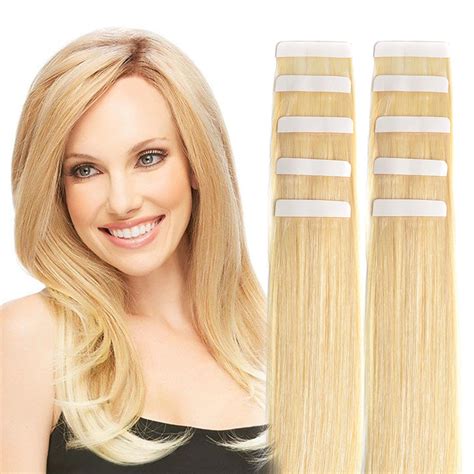Introduction
Tape in hair extensions human hair have become increasingly popular in recent years, offering a convenient and virtually undetectable way to add length, volume, and color to your natural hair. This comprehensive guide will delve into every aspect of tape in hair extensions, from the different types available to the benefits, application process, and proper care.

Types of Tape In Hair Extensions
1. Remy Hair Tape In Extensions:
- Made from 100% human hair, preserving the hair’s natural cuticle orientation for a seamless blend
- Available in various textures, colors, and lengths
2. Synthetic Hair Tape In Extensions:
- Made from artificial fibers, offering an affordable option
- Less durable than human hair extensions but available in a wider range of colors and styles
Benefits of Tape In Hair Extensions
1. Versatile:
- Can be used to add length, volume, or highlights to your natural hair
- Suitable for various hair types and textures
2. Convenient:
- Easy to apply and remove at home or by a professional
- Can be reused multiple times with proper care
3. Damage-Free:
- Unlike clip-in extensions, tape in extensions do not put stress on your natural hair, causing minimal damage
4. Natural-Looking:
- When applied correctly, tape in extensions are virtually undetectable, blending seamlessly with your natural hair
Drawbacks of Tape In Hair Extensions
1. May Cause Irritation:
- The adhesive tape can irritate sensitive skin
- Regular touch-ups are required to prevent the tape from loosening
2. Limited Lifespan:
- Typically last 6-8 weeks, depending on care and maintenance
- Regular touch-ups are essential to maintain the extensions’ longevity
3. May Interfere with Styling:
- Extensions may need to be styled differently than your natural hair
- Certain hairstyles, such as high ponytails, may not be possible with extensions in
Application Process
1. Preparation:
- Wash and blow-dry your natural hair
- Divide your hair into sections
2. Tape Application:
- Peel off the protective backing from the tape
- Place a small section of your natural hair between two strips of tape
- Press the tape together firmly
3. Removal:
- Use a professional tape remover
- Apply the remover to the base of the tape
- Gently pull the extension away from your natural hair
Care and Maintenance
1. Regular Washing:
- Wash your extensions with sulfate-free shampoo and conditioner
- Avoid using hot water, which can damage the extensions
2. Avoid Heat Styling:
- Heat can weaken the tape adhesive
- If styling with heat is necessary, use low heat settings and a heat protectant spray
3. Regular Touch-Ups:
- Touch-ups are necessary every 6-8 weeks
- A professional stylist can remove and reapply the extensions, ensuring a secure and long-lasting hold
Cost and Availability
The cost of tape in hair extensions human hair varies depending on factors such as hair quality, length, and color. On average, you can expect to pay between $200-$500 for a full set of extensions. They are widely available at beauty supply stores, salons, and online retailers.
Future Applications
As the demand for tape in hair extensions continues to grow, innovative applications are being developed. One emerging trend is the use of microphone tape in hair extensions. This type of tape is designed to absorb and amplify sound, creating a more immersive audio experience for musicians and audio engineers.
Conclusion
Tape in hair extensions human hair offer a versatile and damage-free way to transform your hair. By choosing the right type, applying them correctly, and following proper care instructions, you can enjoy beautiful, long-lasting extensions that will enhance your appearance and boost your confidence.
Additional Information
Tables
| Table 1: Comparison of Tape In Hair Extension Types |
|—|—|
| Feature | Remy Hair | Synthetic Hair |
| Hair Type | Human hair | Artificial fibers |
| Durability | More durable | Less durable |
| Cost | More expensive | Less expensive |
| Color Range | Limited | Wider range |
| Table 2: Popular Tape In Hair Extension Colors |
|—|—|
| Color | Code |
| Black | #1 |
| Brown | #2 |
| Blonde | #613 |
| Highlights | #18 |
| Ombre | #1B/#6 |
| Table 3: Estimated Lifespan of Tape In Hair Extensions |
|—|—|
| Hair Type | Lifespan |
| Remy Hair | 6-8 weeks |
| Synthetic Hair | 4-6 weeks |
| Table 4: Care and Maintenance Tips for Tape In Hair Extensions |
|—|—|
| Tip | Description |
| Use sulfate-free shampoo and conditioner | Prevents damage to the extensions |
| Avoid heat styling | Can weaken the tape adhesive |
| Get regular touch-ups | Ensures a secure and long-lasting hold |
Strategies for Success
- Choose a reputable hair extension supplier
- Consult with a professional stylist for proper application and maintenance
- Invest in quality hair extensions made from Remy human hair
- Follow proper care instructions to prolong the lifespan of the extensions
- Experiment with different colors and styles to create a personalized look
